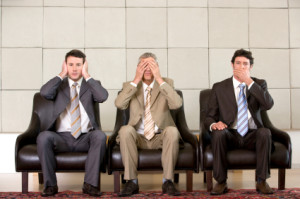MY FRIEND JONAH DOESN’T like conference rooms.
That’s why he’s held client meetings at Wegman’s. And Barnes and Noble. And a nearby donut shop.
He meets with his staff at a local Texas Roadhouse they call by a code name: “Meeting Room T.”
In fact, Jonah would rather meet anywhere than in a corporate conference room, and he’s not alone.
Many leaders find that conference rooms inhibit creative thinking and innovation.
Meeting in the same sterile room over and over again doesn’t provide the kind of novel stimuli that distracts some people just enough to get creative ideas flowing and loosens others up so they feel comfortable contributing their ideas.
Also, typical meeting spaces tend to produce typical results as people play expected roles within a hierarchy, rather than thinking creatively and sharing their ideas.
As well, the traditional layout of corporate conference rooms may reinforce the idea that the person sitting at the “head” of the table is supposed to talk and everyone else is supposed to listen.
Is your conference room an idea graveyard?
Here are three ways for breaking out of the same old same old:
- For brainstorming sessions, get out of the office. Go to a local restaurant, a club or even a museum to place employees in a novel environment.
- If you find a location that’s particularly effective, stick with it. Jonah’s meetings at Wegmans have been working month after month.
- While you can continue to use your traditional conference room for basic staff meetings/updates, reserve other rooms for specific purposes … you might use one room for identifying the causes of problems, and another for “blue sky” sessions to find solutions to problems.
Don’t go for what’s novel just for the sake of it — you can increase the effectiveness of novel meeting spaces by letting employees know why you are leaving the conference room behind. Your explanation for the benefit of getting away from a stodgy conference room can help them prepare for breakout thoughts and ideas.


Hi David
That is great advice about the meeting room, and in the past we have had some shockers. I will have to implement getting everyone out of the office more for thinking sessions. We have just re-done our meeting room and now have a large square desk, therefore there is no head of the table, which has helped.
Regards
Tyson.
Thanks, Tyson! I think the book “The Medici Effect” had an impact on how I view meetings,particularly when you’re looking for new ideas.
He describes a “thought walk” in the book, an exercise where you just take a walk around (doesn’t matter where) and select a random object to associate to, and then link it back to the problem you’re trying to solve … it’s a cool exercise and more evidence that if we want to think in different ways, maybe going back into the same boring conference room doesn’t cut it. 🙂